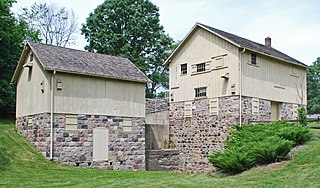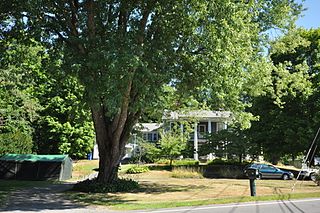
Four Mile Tree is the name of a plantation near Jamestown, Virginia that once encompassed two thousand acres (8 km²), it was situated on the south bank of the James River opposite Jamestown, four miles (6 km) further north. On a hill near the water's edge a handsome old house overlooks the river. This plantation, was the seat of the Browne family for two hundred years. The first owner, Colonel Henry Browne, was a member of Sir William Berkeley's Council in 1643. The plantation house constructed circa 1745 remains well-preserved in its original historical state.

The Boston Manufacturing Company was a business that operated one of the first factories in America. It was organized in 1813 by Francis Cabot Lowell, a wealthy Boston merchant, in partnership with a group of investors later known as The Boston Associates, for the manufacture of cotton textiles. It built the first integrated spinning and weaving factory in the world at Waltham, Massachusetts, using water power. They used plans for a power loom that he smuggled out of England as well as trade secrets from the earlier horse-powered Beverly Cotton Manufactory, of Beverly, Massachusetts, of 1788. This was the largest factory in the U.S., with a workforce of about 300. It was a very efficient, highly profitable mill that, with the aid of the Tariff of 1816, competed effectively with British textiles at a time when many smaller operations were being forced out of business. While the Rhode Island System that followed was famously employed by Samuel Slater, the Boston Associates improved upon it with the "Waltham System". The idea was successfully copied at Lowell, Massachusetts, and elsewhere in New England. Many rural towns now had their own textile mills.

Two 19th century factory buildings are sited on a bank beside Starr Mill pond on Beverly Heights just off Middlefield Street. Each building is 3½ stories tall, and overlooks a picturesque pond and woods to the west; a parking lot packed with trucks and industrial equipment on the south; and nineteenth century housing on Beverly Heights to the north.

Gladden Windmill is an historic windmill formerly located on Pigeon Valley Road in Napoli, Cattaraugus County, New York. The windmill was built in 1890 and is a well-preserved example of a vertical wind turbine built during the 19th century. Although no longer operational, the turbine is a rare example of wind power technology in the United States.

The Eaton-Moulton Mill is a historic industrial building at 37 Walnut Street in the Wellesley Lower Falls village of Wellesley, Massachusetts. The 2-1/2 story granite mill building was built c. 1853 by the firm of Reuben Ware and William Clark, manufacturers of papermaking machinery. The building is distinctive for its use of stone, a relatively uncommon construction material in this area. The Lower Falls area of Wellesley and Newton developed as a papermaking center in the 18th century, and began transitioning from handmade methods to machine methods producing rolls of paper in the 1830s. Ware and Clark were at the forefront of this transition, establishing a machine shop in 1832 where the manufactured equipment for this new process. This building was built for them in 1853, and continued under Eaton and Moulton and other owners until papermaking declined. The building now houses commercial office space.

The William Winter Stone House is a historic residence in Clermont County, Ohio, United States. Constructed at the dawn of the nineteenth century, it was home to some of the area's first settlers, and it has been named a historic site.

The McClelland Homestead is a historic farm in western Lawrence County, Pennsylvania, United States. Located along McClelland Road northeast of Bessemer, the farm complex includes buildings constructed in the middle of the 19th century. It has been designated a historic site because of its well-preserved architecture.

Allen's Cider Mill is a historic cider mill at 7 Mountain Road in Granby, Connecticut. With a history extending back to 1783, it was at the time of its listing on the National Register of Historic Places in 1992 one the few operational cider mills in the state of Connecticut. It is presently abandoned.

The Louis P. and Clara K. Best Residence and Auto House, also known as Grandview Apartments and The Alamo, is a historic building located in the central part of Davenport, Iowa, United States. It was included as a contributing property in the Hamburg Historic District in 1983, and it was individually listed on the National Register of Historic Places in 2010.

The Parker–Hutchinson Farm is a historic farm property on Parker Bridge Road in Coventry, Connecticut. It includes the Samuel Parker House which dates from 1850. The significance of the property is not for the architecture of its farmhouse, but rather as a remarkably intact site where a number of small-scale industrial enterprises were conducted. The property was listed on the National Register of Historic Places in 1982.

Messerschmidt Pond Wildlife Management Area is a tract of land in Westbrook and Deep River, Connecticut, adjacent to Cockaponset State Forest. The area includes the millpond and former site of the Deep River Manufacturing Company, which preserved a variety of historic manufacturing machinery until its demolition in 1987. The mill and an associated shed and dam were listed on the National Register of Historic Places in 1985.

Wallace-Cross Mill is a historic grist mill located at East Hopewell Township, York County, Pennsylvania. It was built in 1826, and is a 2 1/2-story, frame building on a stone foundation. It has a gable roof with decorative bargeboard. It has an 11 feet in diameter, 4 feet wide, steel water wheel to run the machinery. The mill was given to York County by its owner in 1979.

The Louden Machinery Company was an American engineering, manufacturing and design company based in Fairfield, Iowa. Founded by William Louden, the company in its early years manufactured and sold the patented hay carrier that he invented in 1867. The company later expanded into a wide variety of farm equipment and, in 1906, began an Architecture Department that reportedly designed more than 25,000 barns from 1906 to 1939. During World War I, Louden's monorail equipment carrier began to be applied to industrial and military applications. By the 1920s, much of the company's revenues were derived from industrial applications of its monorail equipment carriers.

The Parker Mill, also known as Parker Mill Park or Parker Mill Complex, is a mill located at 4650 Geddes Road, east of Ann Arbor, Michigan. The mill is a well-preserved example of a small-scale grist mill operation that was once common in Michigan. The mill and nearby Parker House were listed on the National Register of Historic Places in 1982.

The Kregel Wind Mill Company produced water pumping windmills in Nebraska City, Nebraska starting in 1879. It is now the Kregel Windmill Factory Museum.

The Kenneth and Phyllis Laurent House is a Frank Lloyd Wright-designed Usonian house in Rockford, Illinois. It was the only house that Wright designed for a physically disabled client.

The McClure-Hilton House is a historic house at 16 Tinker Road in Merrimack, New Hampshire. The oldest portion of this 1-1/2 story Cape style house was built c. 1741, and is one of the oldest surviving houses in the area. It was owned by the same family for over 200 years, and its interior includes stencilwork that may have been made by Moses Eaton Jr., an itinerant artist of the 19th century. The property also includes a barn, located on the other side of Tinker Road, which is of great antiquity. The property was listed on the National Register of Historic Places in 1989.

The Fred and Rosa Fulton Barn is a historic building located north of Selma, Iowa, United States in rural Jefferson County. The barn was built by Rosa from plans prepared by the Louden Machinery Company of Fairfield, Iowa. It is a good example of the company's Gothic laminated roof design. The barn also includes other Louden-manufactured devices, including "Master-Made" ventilator windows, metal roof aerators, hay carrier and fork, and door tracks and trolleys. This equipment is original to the barn's construction in 1947. Built for a dairy operation, the structure has subsequently been used for general farm purposes. The barn was listed on the National Register of Historic Places in 1999.

The Whitfield Cowles House is a historic house at 118 Spoonville Road in East Granby, Connecticut. Built about 1785, it was home to one of the early innovators in the development of silver plating, and was still owned by Cowles descendants. It was listed on the National Register of Historic Places in 2014.

The Knockando Woolmill is a historic woolmill in Moray, Scotland. Wool production has taken place at the site since at least the eighteenth century, and the surviving buildings house a number of pieces of historic machinery which are still in operation. It was designated a Category A listed building in 1995, still operates as a working mill, and is open to the public from April to September.






















